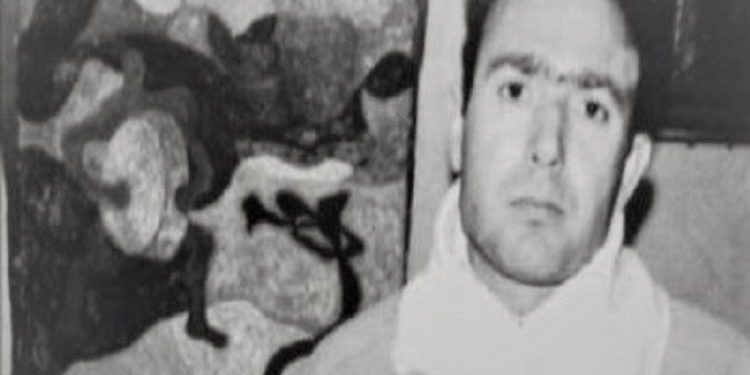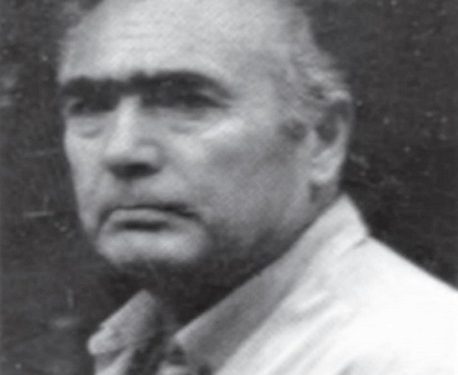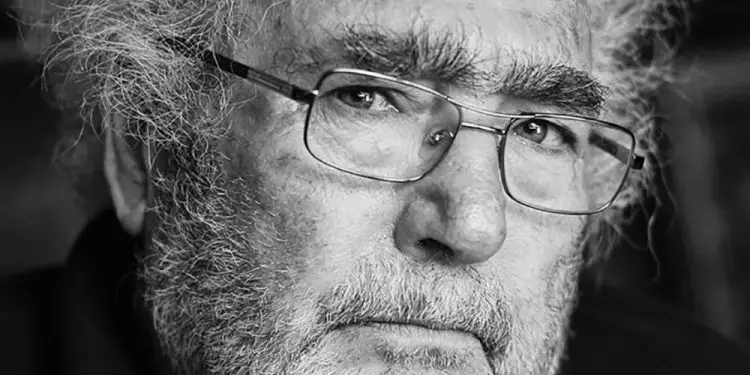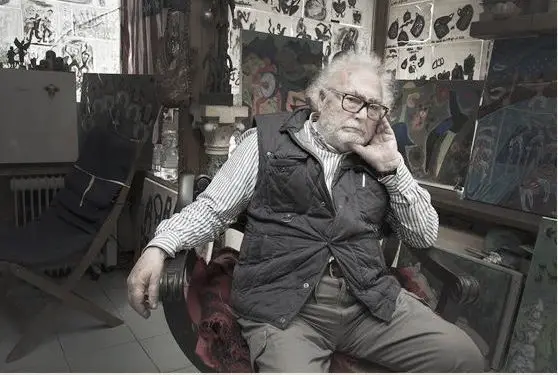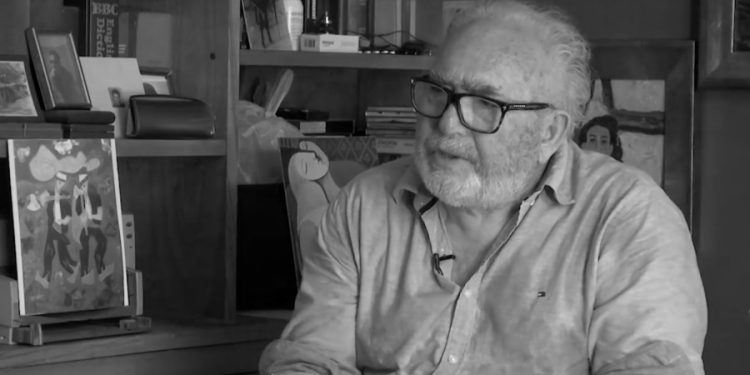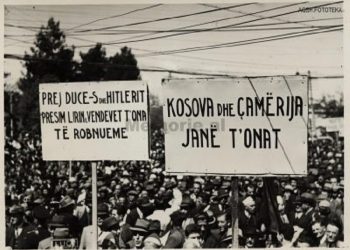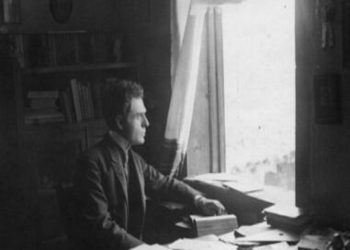By Max Velo
Memorie.al / Max Velo were born in Paris on August 31, 1935, where his family, originally from the village of Dardhë e Korça, was living. Then the Velo family returned to Albania, to the city of Korça, where Maksi also spent his childhood. After finishing high school in the city of Korça, he continued his studies at the Polytechnic Institute in Tirana, in the Civil Engineering branch and then he also specialized in architecture and in 1960, he was appointed to work at the urban planning office of the District Executive Committee of Tirana. In addition to his work as an architect and urban planner, he had a passion for painting and since the mid-60s; he has participated with his works in various exhibitions that took place in the Albanian capital, Tirana. In 1973, when the crackdown on Art and Culture began, Max Velo was one of the painters and creators who were criticized for foreign and liberal performances and modernism, which led him to destroy and burn most of his works. After that, he was dismissed from his job as an architect in the Executive Committee of Tirana and sent for re-education in the villages of Tirana as a manual worker. From that time he was targeted by the State Security and in 1976, he was arrested on the charge of “agitation and propaganda” and was sentenced to 10 years of imprisonment, all of which he served in Spaçi prison camp. . After his release from prison, Velo was assigned to work at the Abrasive Production Company in Tirana, where he worked until the beginning of the 90s, when the communist regime collapsed. In that period of time, Maksi returned to his creativity and managed to publish a series of albums, with motifs from communist terror, which he exhibited in many European countries. Velo is also the author of a series of publications such as: “Shaving his head”, “Prison coat”, “Prison bag”, “Parallel for architecture”, “Anti-sign time”, “My life in pictures”, etc. As an artist, he created in several genres of art: such as painting, prose, poetry, journalism, etc., and he was also engaged in current Albanian issues, mainly in the protection of cultural heritage and public works of art. He passed away in Tirana on May 7, 2020. The writing we have selected for publication is excerpted from one of his books, where it is about a real event from his life.
VILLAGE CROSSES
The village had many crosses, but the heaviest were those of the graves.
The village graves were on a small plateau about fifty by thirty paces. The plateau was steep, and about two-thirds of the way across, it folded back uphill and went uphill. From above it was surrounded by stones, behind which continued a dense forest that had never been pruned.
A stone fence continued on the side of the highway, and on the lower side, there was a retaining wall, sloping, that stood there motionless. In the middle of this wall were six steps leading to the cemetery.
The graves were very close to the church, separated by the road.
The church was a large building, a real cathedral, where candles were lit for inspiration throughout the year. It was the women of the village who lit them to remember their dead relatives.
At the front, the iconostasis carved in walnut wood was filled with icons made by village iconographers. Until recently, there were twenty-two. These, the Pear iconographers, also had a workshop on Mount Athos.
The church was located on the ridge of the mountain and when the bells rang bam-boom, bam-boom, the villagers, men and women, children and young people, old people who could barely walk, took the stone roads of the village sighing, but in the church, in the mass they would go…!
On Sundays, the whole village gathered for mass, and there you could judge the culture and tradition that this village, hidden in the middle of the mountains, carried with it.
The church, the yard was as big as the graves, and on the stones of the steps under the arches, after mass, the whole village sat in groups. The old people crossed that little place and went up to the cemetery…! I could see them walking slowly like old men, bent over to protect the light of the candle they were holding in their left hand.
They took the light of the church to the graves and put the candles on the stone crosses.
I followed my grandmother, Memena, from behind. Her only son had died young; he had caught a cold on a mountain road. Her mother and father were also there.
He sat down, dripped the hot wax, stuck the candle and cried in a muffled voice…oh biro…! I would sit on the ground, turn my head and look at the crosses. They were stone crosses, in a dark gray color, with some white and green moss spots, which were attached to them, and did not come off. These are the little spirits. So my soul, one day will climb a cross… I thought.
The crosses were heavily embedded, some standing straight, some bent from fatigue, either from the front or from the back.
They cannot bear the weight of suffering, I said…!
They had letters and numbers engraved on their chests… there was the whole history of the village.
All the safety of the life of the village was kept in these crosses; all love and respect for the elders.
And every time I remembered the village in the distance, that lawn with dry grass appeared in front of me, from where the heavy crosses of human memory rose. These stones were not placed in regular rows, with their irregularity; they conveyed independent spirits, restless consciences, and major whims.
One cross was higher, the other lower.
The crosses looked like they were looking at each other, like the houses in the village. And the crosses seemed to me as if they were hidden, sticking out their heads to eavesdrop.
The village was located there in a strategic position, because it was a runaway village. It looked like a waiting village, ready to go on a journey. Our village was located there to hide from the Turkish persecutions. There were four entrances and exits, four necks.
Some mountain peaks hung above him like giant phantoms, while he himself was stuck on a cliff.
Cap’s stone, autumn’s stone… Rahu’s stone.., Mark’s stone.., everything was connected to the stones, and the village was made of stone.
It looked like a stone on a stone, beautiful, worked, suffered, exhausted…!
Streets, thresholds of houses, courtyards, and roofs were living stone…
I liked to see the village from afar…!
From the road of Sinica, when the sun was setting, it seemed to me as if the whole village had caught fire and a new village had been born, baptized from above.
I used to see it from Biglla Street when we took our last break… and it looked like a bunch of komites sitting with their bags on their sides, ready to go…!
I could see it from the top of Saint Peter; it looked like a caravan on vacation…!
The whole village was green, this entire crown of energy and human honesty, had those crosses in the center, which seemed to me to speak and show without haste all the sufferings that the village had endured over the centuries, in order to preserve its good name. The village codicil was there at the grave crosses.
The village also had its own codex where all its main events were recorded, but it seemed to me that the codex that was read at a glance, were those grave crosses. On a rainy evening in the fall of 1968, I found out that the grave crosses had been broken in the village.
The Party Committee of Korça and the Department of Internal Affairs had forced the villagers to break the stones. The stories were fragmented, scary, and heavy. They had gathered them in the Council, then in the school. The meetings had continued several days in a row until late at night.
The event was told as a conspiracy.
After a wedding, where the rejoicing lasted until late, the next morning, writings were seen under the chairs – Glory to God. That same night, a large banner with capital letters was written on a wall – Glory to Christ.
Party and Security cadres had urgently arrived from Korça. The border dog was also brought, which led the scent to a separate house.
They charged a student who was there, but he was dumb and lame.
Every day there were meetings after meetings and unmasking’s. The second secretary of the Party Committee of Korça T.L. participated in these meetings as well as the vice-president of the N.D. Branch, the Secretary tried to soften the atmosphere, but the delegates of the Internal Branch were adamant: this village is religious and must be cleansed.
Those villagers who remained in the village did not know where to go. They also accused the village priest of having organized it all. The order was to close the church, burn the icons and break the crosses on the graves.
It was a cold morning and everyone, gathered in front of the church, was crouching.
They took them to the cemetery and assigned a cross to each of them.
– This is action against religion… break the crosses or it’s you, the instigators of the slogans.
The elders and boys of the village began to break the stone arms with pickaxes, pickaxes and crowbars.
– Priest strength, give… break… break the crosses…!
After breaking all those heavy crosses, the ground of the graves was filled with fragments of arms, heads, and stone bodies.
It had now turned into a cemetery of grave crosses…!
I rarely went to the village.
I started with a group of athletes from Tirana, who were going skiing. It was 1970. We walked the Korçë-Dardë road from Drenova, loaded with food and skis on our backs. When we reached the village, I dropped the loads, drank some mountain tea and went up from the church.
The bell tower of the church was demolished and the arches of the porch were destroyed. The wooden iconostasis was walled up with a second wall.
I turned my head from the cemetery. Snow had covered that small plateau. There was no trace. No one had entered. It seemed to me that the whole village was under that white carpet, under that plateau.
The white surface was all bumpy… just a few lonely stones here and there, left like the last soldiers in a battle. Those who did not want to give up. The stones were barely recognizable as having been crosses… they had tilted… fallen… fallen… fallen…! And the color seemed changed to me, as if they were more blackened, as if they didn’t want to live anymore.
The earth seemed to be swollen and puffy… all bumpy…!
After ten months, in the spring, the elders of the village decided to move the graves from there to the exit of the village, on the road to Saint Peter, near the stream of the Rahu grove.
N.D. was lab, the first cousin of K.H., the Minister of the Interior. At the Polytechnic Institute, where I met him, he was a year ahead of me, and he graduated from the Faculty of Civil Engineering in 1965. That course completed the faculty in four years, while we graduated in five.
Since he was a student, he was in the party, he commanded the Institute and we all feared him. The director of the Institute Z.K. he was laughing. There were some sharp movements, where safety and the lack of any ethics were noticeable. What impressed me about him was the metallic look in his green eyes. After graduating from the Institute, he immediately moved to the Ministry of the Interior.
In 1973, in a conversation with the writer T.L., in the tourism café of Fier, he tells him that the events of the drama that followed the massacre of crosses and icons were all prepared by him.
…In the camp, I read the newspaper every day, regularly. As soon as I saw the tellalli, Xarxalloja, coming down the stairs with the newspaper in hand, I started towards the stand.
The stand was the size of a newspaper with glass on both sides, to be read both on the outside and on the inside.
These Party newspapers are thought to be better. There are only four pages. That’s how they all were, “Voice of the People”, “Union”, “Work”, “and Youth”.
In those four pages, they summed it all up.
And all of them were the successes of Albania and the defeats of the rest of the world.
I approached the stand and immediately at the bottom of page four an obituary caught my eye. I understood instantly. N.D. had died. A picture was published with a military outfit, the likes of which I had never seen before. In my life I had only seen him as a civilian. These types of photos were published only in obituaries.
It was 1979… I was in the camp yard.
The three who had prepared and implemented my arrest: N.H., K.I. and N.D. all three had died in recent years, one after the other. I felt a strange satisfaction like a decision from above, like a heavenly vengeance, like a consolation being sent. You will suffer… as if it was the message, but these had no right to live anymore.
Later, until the end of 1982, the three Interior Ministers who led the Ministry from 1948 were also executed: M.Sh., K.H., F.SH.
Both for all the prisoners and for me it was a great relief. We continued to suffer, but the Ministry of the Interior had declared its bankruptcy. She was eating herself.
I was looking at the obituary photo. These photos are from the personal file in the staff office. They have a special look. To all the major officers of the Ministry of the Interior, it is the same look.
A servile loyalty and a promise to be ready for any crime. This kind of look, they reveal intimately only in front of the camera. There you can see malice, ignorance, lack of any positive logic, servility, intellectual poverty.
There they discover the secret thoughts, the unspoken desires, the goals of an unscrupulous ego, the dreams of promotions and positions.
But I was sure that they all dreamed of the post of deputy minister. This post was left vacant. Many deputy ministers had brought them out as traitors, imprisoned, poisoned, exiled. You could eat the head of the Deputy Minister of the Interior, but not the minister.
The Minister of the Interior was the third person in Albania. They were appointed by Enver, and therefore you were not allowed to dream about that post. Until then, at the deputy minister’s post, they think secretly, beyond that they don’t have the courage, I said to myself.
I kept seeing the obituary photo.
The look was direct, shameless; you couldn’t discern any human feeling, no sorrow, and no sense of pain.
This picture showed unyielding, indomitable, irrevocable people.
The sight conveyed a cold, impenetrable zone where every human being freezes.
This view had stratifications of crime, stratifications that came from primitive times, passed through antiquity and through the middle Ages, reached modern times.
All people have their ancestors. Who were those who were like me from five thousand years ago… how many were there and whom do I follow… who will come after me and be like me?
This century, state crime is associated with philosophical theories, but the applicants, those who deal directly with crime, have the same ferocity of the first criminal… who was the last animal, who did not want to turn into a man.
…I was in the investigator. I had been alone for several months. I had eaten the dinner soup; we had completed the other actions of the daily ritual: we had gone to the bathroom and the policeman had lit our after-dinner cigarette, which was the last cigarette.
I was moving slowly, parallel to the darkness of the evening. The light of the lamp from above was like a hope extinguished forever.
I used to go to the wall and come back… I was barefoot and walked softly like a child, when I jumped from the bed and attacked my brother for a fight. I was remembering these when suddenly I hear the small window of the door open. I stood in the middle of the room. I was two meters close.
There in the corridor, it was dark and I couldn’t understand who was watching me so intently. We were seeing each other in the semi-darkness; the look there was wild, hostile. Finally I caught the icy look in the green eyes. He was the Chairman of the Internal Affairs Branch of Tirana, N.D.
The face left, the window closed with a dry creek.
I stood still… kept seeing that blind window.
Then I slowly raised my outstretched hands. I raised my hands to the horizontal position. My legs could barely support me and my hands on top were shaking, but I continued to stand in that position. I was a living cross in the middle of the dungeon. Memorie.al





